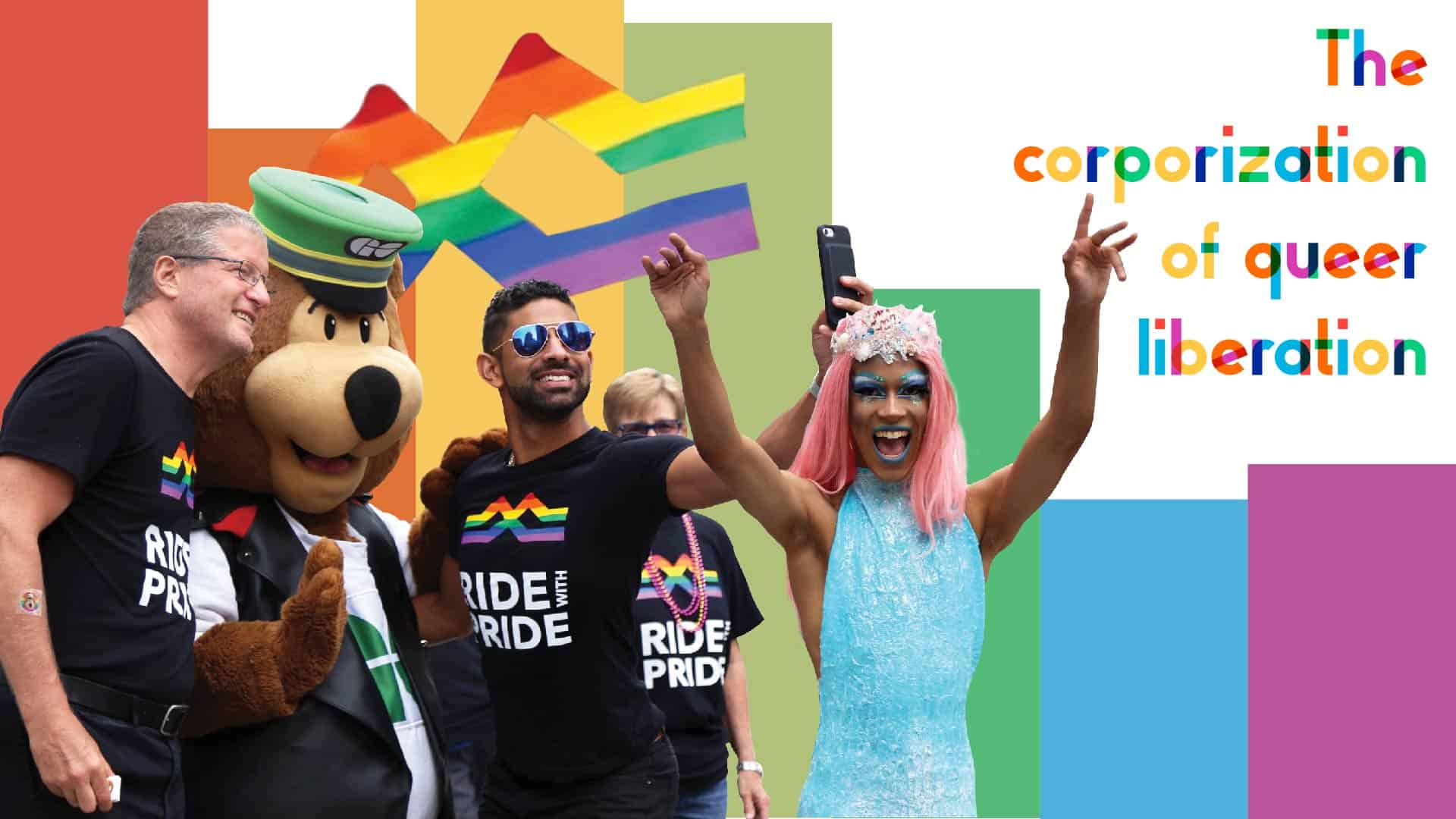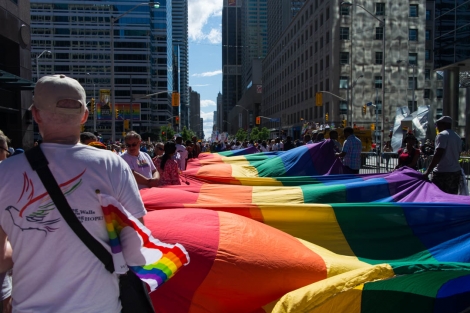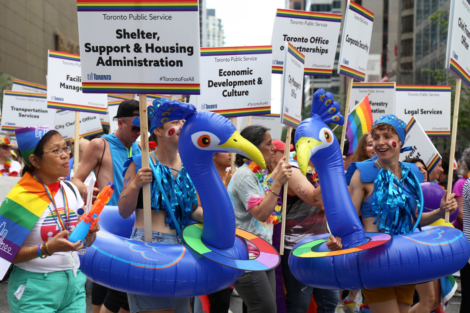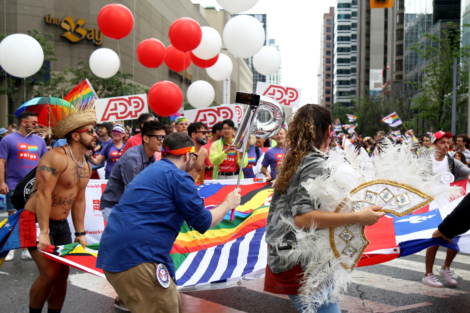[dropcap]H[/dropcap] aving some sort of Pride celebration during the summer months is now par for the course for many major city centres, and more and more, the festivities are spreading into even smaller urban areas. Owen Sound, Ontario, had its very first pride parade this year.
As queer events garner broader attendance, they have also become sought after opportunities for corporate sponsorship and advertisement. However, these advertisements often provoke widespread criticism — can Pride demonstrations stay true to their founding spirit of queer liberation when they’re bankrolled by major corporations?
To spectators at this year’s Pride Parade in Toronto, a corporate presence was extremely visible. Most of the large scale floats sported rainbow coloured logos of large companies like Canada Trust or Bud Light. Yet, while these corporate floats loomed large over the pedestrian element of the parade, many groups on foot carried signage protesting that same corporate involvement, with slogans such as “You Can’t Buy My Pride” or “The ‘T’ in LGBTQ Doesn’t Stand for ‘TD’.”
For some, corporate sponsorship is a benign and necessary aspect of contemporary Pride movements and celebrations. For others, it’s pinkwashing — big business trying to appear queer-friendly in order to seem progressive and gain new marketing opportunities, without necessarily caring about or contributing to the community.
While complaints against corporate involvement in queer events are becoming more frequent, the political environment has changed dramatically. With government funding for queer non-profits already scarce and potentially becoming more so (if the recently scrapped LGBTQ+-friendly sexual education curriculum is any indication), there’s also the question of whether these groups can continue to do work for the queer community without relying on private and corporate funding.
Origins of Pride
The origin of these mid-year celebrations and most contemporary queer organizing is usually acknowledged as the Stonewall Riots of 1969.
In 1969 New York, it was illegal to ‘solicit homosexual relations.’ On June 28 of that year, police conducted a series of raids on bars in Greenwich Village that were thought to be gathering places for the queer community. This culminated in a raid on the Stonewall Inn, which broke into a queer struggle against the police, who ended up barricaded inside the inn.
While members of the community deserve to be highlighted in the events of that night — most notably, trans woman Marsha P. Johnson, who is credited with throwing the first stone of the riots — much of the lasting significance of that night was the lesson of how the queer community could band together to fight their diverse oppressions.
After that night, queer liberation movements gained visibility and momentum. More locally, Toronto Pride celebrations grew out of the Bathhouse Raids of 1981. The Toronto police forces coordinated raids on four major bathhouses that they suspected of prostitution and ‘indecent acts’ — read: queer sexuality.
After a whopping 286 arrests, the raids marked a turning point in Toronto’s queer liberation movement. The queer community grew increasingly politicized and refused to be swept under the rug by police, media, or the public.
Both these events occured, of course, long before large companies would have had any interest in sponsoring queer movements. So how do the events of 1969 and 1981 compare to our modern Pride celebrations, where corporate sponsorships feature prominently in queer organizing?
Contemporary Pride
While both the Stonewall and Bathhouse riots were protests, modern Pride has incorporated more and more celebratory aspects, as milestones of LGBTQ+ liberation become more frequent.
Now that larger corporations and even governments wish to share in Pride celebrations, there is often more competition for visibility.
This was clear in the summer of 2016, when Black Lives Matter (BLM) Toronto staged a protest in the Pride Parade over the growing marginalization of the Black queer community within Pride celebrations.
Pride Toronto ultimately agreed to Black Lives Matter Toronto’s demands. That same year, Justin Trudeau marked the first time that a Canadian Prime Minister ever walked in a Pride celebration, but Trudeau did so without ever publicly acknowledging the BLM protest to which he was in such close proximity.
These events raise questions of who should be privileged and visible at events of queer celebration. As the signage shows, many protestors at this year’s Pride parades and marches argued that corporate sponsorship didn’t belong. However, at the same time, Pride is a non-profit organization. Since it charges no admission to its events, sponsorships are vital to its ability to create queer spaces.
I wrote to Undergraduate Director and Lecturer Dai Kojima from the University of Toronto’s Sexual Diversity Studies Program about the dilemma that queer non-profits find themselves in.
When asked about the potential benefits and risks of major corporate sponsorship, Kojima responded that he viewed the situation as “more complicated than good/bad.” In Kojima’s opinion, “it is too easy to blame non-profits as being complicit in capitalism — as if they can ‘refuse’ to take the money.” He continued, “Many organizations are barely getting by and fighting over small pools of money to fund their programs, pay minimum salaries to their dedicated staff, and rent a basic work space to gather and organize activities.”
Kojima said that not all queer non-profits would even have the option of relying solely on non-corporate funding, especially non-profits that serve the most marginalized elements of the LGBTQ+ community, such as “racial and ethno-specific communities, homeless youths, sex workers, people with disabilities, immigrants and refugees, to name a few.”
He explained that “in the context of Toronto/Ontario, governmental support for these intersectional, queer non-profit organizations is shrinking rapidly — a dire situation made worse by the current Premier’s attack on social supports and public education on gender and sexual diversity.” This means that many more organizations are forced to turn to corporate support to stay viable.
Further, Kojima wrote, “We really have to understand the ambivalent and conflicted ways in which queer organizations — both big and small — work with corporations and governments to fund their work.”
Noulmook Sutdhibhasilp, Executive Director of the non-profit Asian Community AIDS Services (ACAS), echoed Kojima’s call for nuance in these discussions. He noted that issues of corporate sponsorship are directly linked to “a bigger social justice issue” — that is, the “neo-liberalism agenda that shrinks government’s welfare state and continues to direct the responsibilities of social, health, education and other services to be dictated by the market.”
For Sutdhibhasilp, this makes corporate sponsorships essential in providing services to marginalized communities in Toronto and elsewhere.
Sutdhibhasilp also expressed that while “many people are turned off by corporate logos and conditions they impose,” the “PRIDE spirit is in celebrating who we are” and taking up space in the mainstream.
Who are the sponsors?
Sponsors vary widely in industry and how actively they support the queer community, outside of the weekend of Toronto Pride. One of Pride Toronto’s most noted sponsors is TD Banking, which sponsors 83 Pride festivities around North America while also supporting over 160 LGBTQ+ organizations and initiatives.
On the flip side, Bud Light is a major sponsor of Pride Toronto, yet was also a major sponsor of the 2018 FIFA World Cup in Russia. This move was widely criticized due to reports of Russia’s recent and well-documented persecution of LGBTQ+ individuals, particularly its anti-gay purges in Chechnya.
There are also sponsors like Remington’s Men of Steel strip bar, which supports Pride while arguably promoting cisnormative views of beauty and pleasure.
Nevertheless, all of these businesses are willing to put their profits into funding initiatives like Pride Toronto. Is this contribution enough, in return for all the benefits that they get through exposure at Toronto Pride? Or do corporations that can appear accepting and progressive through sponsoring events like Pride have more of a responsibility to engage with the queer community, as TD Bank and other sponsors try to do?
Kojima argued that the debate should not focus on whether corporate money is “always already bad” so much as on questions such as “which agendas are deemed safe and worthy in the eyes of corporate philanthropic programs and which voices remain on the margins?” and, “what systems of value and valuation are at work when corporate and government money is unevenly distributed?”
In that framework, organizations like Pride seem safer and less controversial than organizations serving more marginalized elements of the community, and therefore receive more corporate funding. This leaves organizations serving ethno-culturally specific or poverty stricken aspects of the queer community struggling for funds to keep their services going.
For anyone wanting to support some of those organizations who receive less governmental and corporate funding and remain on the margins, here are a few places you could start:
- Rainbow Railroad: an organization helping LGBTQ+ people from around the world escape state-sponsored violence
- Casey House: Canada’s only stand-alone hospital for HIV/AIDS patients
- Youthline: a completely anonymous hotline for queer youth that provides referrals, support, and recommendations for resources
- ACAS: mentioned briefly above, this organization works to make HIV/AIDS information, as well as general LGBTQ+ resources, available to East and Southeast Asian Communities
Symbolic appropriation?
On a broader scale, questions regarding the effects of the widespread use of queer symbols by large corporations remain. While it can be positive for queer symbols to be more widely accepted and mainstream, Kojima noted that “we must be skeptical of the belief that circulation of symbols and mass consumption of them will somehow lead to some kind of liberation.”
The recent controversy surrounding the new Philadelphia Pride Flag, which incorporates black and brown stripes into the traditional rainbow flag to represent inclusion of queer people of color, highlights this. As Toronto recently experienced with the 2016 BLM protest, this is a much talked about issue in current queer organizing — the drive to ensure that people of color are not ignored when we talk about the queer community, and that this intersectionality is acknowledged.
It’s important to note that as of yet, no corporations have used the Philadelphia flag instead of the traditional rainbow colours. Perhaps the more frequently used “Love is Love” and “PRIDE” are safer, more consumer-friendly options, rather than embracing the contemporary face of the queer community and accepting potential controversy.
Kojima presented an ideal scenario, one that he stressed is only theoretical and not currently the way that corporate sponsorships work: “Ideally corporations should work with queer communities in order to first find out what the pressing needs of that particular community are and ask how their sponsorship will help that cause. Not the other way around.”
“Corporate donors need to let go of the expectation that their sponsorship and donation for queer events and programs will produce direct beneficial return (e.g. corporate visibility, increased positive public perception, monetary gains etc.), and instead should offer financial and other material supports because supporting these initiatives is the right thing to do.”





